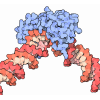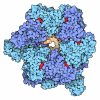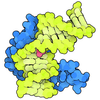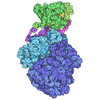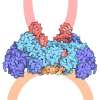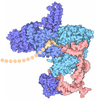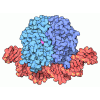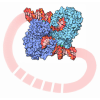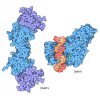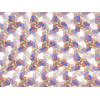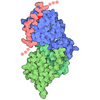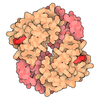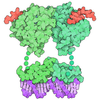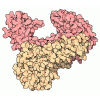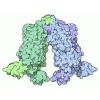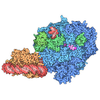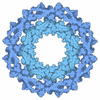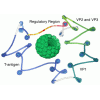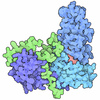+ Open data
Open data
- Basic information
Basic information
| Entry | Database: PDB / ID: 9mlr | ||||||
|---|---|---|---|---|---|---|---|
| Title | GammaH2AX containing nucleosome, Half-wrapped (Class 2) | ||||||
 Components Components |
| ||||||
 Keywords Keywords | NUCLEAR PROTEIN / phosphorylation / nucleosome / nucleosome stacking | ||||||
| Function / homology |  Function and homology information Function and homology informationXY body / chromatin-protein adaptor activity / protein localization to site of double-strand break / response to ionizing radiation / site of DNA damage / negative regulation of tumor necrosis factor-mediated signaling pathway / negative regulation of megakaryocyte differentiation / protein localization to CENP-A containing chromatin / Chromatin modifying enzymes / Replacement of protamines by nucleosomes in the male pronucleus ...XY body / chromatin-protein adaptor activity / protein localization to site of double-strand break / response to ionizing radiation / site of DNA damage / negative regulation of tumor necrosis factor-mediated signaling pathway / negative regulation of megakaryocyte differentiation / protein localization to CENP-A containing chromatin / Chromatin modifying enzymes / Replacement of protamines by nucleosomes in the male pronucleus / CENP-A containing nucleosome / Packaging Of Telomere Ends / Recognition and association of DNA glycosylase with site containing an affected purine / Cleavage of the damaged purine / Deposition of new CENPA-containing nucleosomes at the centromere / Recognition and association of DNA glycosylase with site containing an affected pyrimidine / Cleavage of the damaged pyrimidine / telomere organization / Interleukin-7 signaling / Inhibition of DNA recombination at telomere / RNA Polymerase I Promoter Opening / Meiotic synapsis / Assembly of the ORC complex at the origin of replication / positive regulation of DNA repair / DNA damage checkpoint signaling / Regulation of endogenous retroelements by the Human Silencing Hub (HUSH) complex / SUMOylation of chromatin organization proteins / DNA methylation / epigenetic regulation of gene expression / Condensation of Prophase Chromosomes / Chromatin modifications during the maternal to zygotic transition (MZT) / replication fork / SIRT1 negatively regulates rRNA expression / HCMV Late Events / innate immune response in mucosa / condensed nuclear chromosome / ERCC6 (CSB) and EHMT2 (G9a) positively regulate rRNA expression / PRC2 methylates histones and DNA / Regulation of endogenous retroelements by KRAB-ZFP proteins / Defective pyroptosis / meiotic cell cycle / male germ cell nucleus / HDACs deacetylate histones / Regulation of endogenous retroelements by Piwi-interacting RNAs (piRNAs) / Nonhomologous End-Joining (NHEJ) / RNA Polymerase I Promoter Escape / lipopolysaccharide binding / Transcriptional regulation by small RNAs / Formation of the beta-catenin:TCF transactivating complex / Activated PKN1 stimulates transcription of AR (androgen receptor) regulated genes KLK2 and KLK3 / double-strand break repair via homologous recombination / RUNX1 regulates genes involved in megakaryocyte differentiation and platelet function / HDMs demethylate histones / G2/M DNA damage checkpoint / NoRC negatively regulates rRNA expression / DNA Damage/Telomere Stress Induced Senescence / B-WICH complex positively regulates rRNA expression / PKMTs methylate histone lysines / Meiotic recombination / Pre-NOTCH Transcription and Translation / RMTs methylate histone arginines / Activation of anterior HOX genes in hindbrain development during early embryogenesis / Transcriptional regulation of granulopoiesis / HCMV Early Events / antimicrobial humoral immune response mediated by antimicrobial peptide / structural constituent of chromatin / antibacterial humoral response / nucleosome / heterochromatin formation / double-strand break repair / nucleosome assembly / E3 ubiquitin ligases ubiquitinate target proteins / Recruitment and ATM-mediated phosphorylation of repair and signaling proteins at DNA double strand breaks / site of double-strand break / HATs acetylate histones / RUNX1 regulates transcription of genes involved in differentiation of HSCs / Factors involved in megakaryocyte development and platelet production / chromatin organization / MLL4 and MLL3 complexes regulate expression of PPARG target genes in adipogenesis and hepatic steatosis / Processing of DNA double-strand break ends / Senescence-Associated Secretory Phenotype (SASP) / spermatogenesis / histone binding / Oxidative Stress Induced Senescence / defense response to Gram-negative bacterium / gene expression / killing of cells of another organism / Estrogen-dependent gene expression / damaged DNA binding / chromosome, telomeric region / defense response to Gram-positive bacterium / Ub-specific processing proteases / nuclear speck / cadherin binding / Amyloid fiber formation / protein heterodimerization activity / DNA damage response / centrosome / enzyme binding / protein-containing complex Similarity search - Function | ||||||
| Biological species |  Homo sapiens (human) Homo sapiens (human)synthetic construct (others) | ||||||
| Method | ELECTRON MICROSCOPY / single particle reconstruction / cryo EM / Resolution: 3.1 Å | ||||||
 Authors Authors | Panigrahi, R. / Edwards, R. / Glover, J.N.M. | ||||||
| Funding support |  Canada, 1items Canada, 1items
| ||||||
 Citation Citation |  Journal: Nucleic Acids Res / Year: 2025 Journal: Nucleic Acids Res / Year: 2025Title: Structural insights into γH2Ax containing nucleosomes. Authors: Rashmi Panigrahi / Ross Edwards / Md Touhidul Islam / Jun Lu / Ayodeji Kulepa / Tae Hwan Kim / J N Mark Glover /  Abstract: The phosphorylation of the histone variant H2AX on the nucleosome, yielding γH2AX, acts as a 'master control switch', signaling the recruitment of DNA repair factors at DNA double-stranded break ...The phosphorylation of the histone variant H2AX on the nucleosome, yielding γH2AX, acts as a 'master control switch', signaling the recruitment of DNA repair factors at DNA double-stranded break sites. This phosphorylation is recognized by BRCA1 carboxy-terminal (BRCT) domains of specific repair proteins. Using cryogenic electron microscopy (cryo-EM), we provide structural insights into diverse mononucleosome architectures and inter-nucleosomal interactions in the presence of H2AX, mimicking nucleosomes during DNA repair. We resolved three distinct stacked structures where the nucleosomal dyad axes and disk planes align parallel. The inter-nucleosomal interactions involve unique contacts mediated by the H4 N-terminal tail, exposed H2B elements, and DNA. Geometric analysis of stacking constraints, including published structures, reveals a tight distribution of rotational parameters around 0o, with the greatest variability in the translational parameter 'slide'. Our studies indicate that phosphorylation-dependent binding of BRCT domains with γH2AX nucleosomes disrupts stacking. However, no clear densities for BRCT proteins were observed, indicative of dynamic interactions. Molecular simulations replicate the stability of BRCT binding to γH2AX but do not indicate stable docked conformations of BRCT to nucleosome. We propose that BRCT recognition of γH2AX nucleosomes could contribute to chromatin decondensation during DNA damage signaling, exposing the nucleosomal acidic patch for repair factor recognition. | ||||||
| History |
|
- Structure visualization
Structure visualization
| Structure viewer | Molecule:  Molmil Molmil Jmol/JSmol Jmol/JSmol |
|---|
- Downloads & links
Downloads & links
- Download
Download
| PDBx/mmCIF format |  9mlr.cif.gz 9mlr.cif.gz | 493.5 KB | Display |  PDBx/mmCIF format PDBx/mmCIF format |
|---|---|---|---|---|
| PDB format |  pdb9mlr.ent.gz pdb9mlr.ent.gz | 395.5 KB | Display |  PDB format PDB format |
| PDBx/mmJSON format |  9mlr.json.gz 9mlr.json.gz | Tree view |  PDBx/mmJSON format PDBx/mmJSON format | |
| Others |  Other downloads Other downloads |
-Validation report
| Summary document |  9mlr_validation.pdf.gz 9mlr_validation.pdf.gz | 1.3 MB | Display |  wwPDB validaton report wwPDB validaton report |
|---|---|---|---|---|
| Full document |  9mlr_full_validation.pdf.gz 9mlr_full_validation.pdf.gz | 1.3 MB | Display | |
| Data in XML |  9mlr_validation.xml.gz 9mlr_validation.xml.gz | 40.4 KB | Display | |
| Data in CIF |  9mlr_validation.cif.gz 9mlr_validation.cif.gz | 62.9 KB | Display | |
| Arichive directory |  https://data.pdbj.org/pub/pdb/validation_reports/ml/9mlr https://data.pdbj.org/pub/pdb/validation_reports/ml/9mlr ftp://data.pdbj.org/pub/pdb/validation_reports/ml/9mlr ftp://data.pdbj.org/pub/pdb/validation_reports/ml/9mlr | HTTPS FTP |
-Related structure data
| Related structure data |  48378MC  9mllC  9mlnC  9mlsC  9mmkC  9mmmC  9mmnC  9mmoC  9mmtC M: map data used to model this data C: citing same article ( |
|---|---|
| Similar structure data | Similarity search - Function & homology  F&H Search F&H Search |
- Links
Links
- Assembly
Assembly
| Deposited unit | 
|
|---|---|
| 1 |
|
- Components
Components
-Protein , 4 types, 8 molecules AEBFCGDH
| #1: Protein | Mass: 17907.770 Da / Num. of mol.: 2 Source method: isolated from a genetically manipulated source Source: (gene. exp.)  Homo sapiens (human) Homo sapiens (human)Gene: H3C1, H3FA, HIST1H3A, H3C2, H3FL, HIST1H3B, H3C3, H3FC HIST1H3C, H3C4, H3FB, HIST1H3D, H3C6, H3FD, HIST1H3E, H3C7, H3FI, HIST1H3F, H3C8, H3FH, HIST1H3G, H3C10, H3FK, HIST1H3H, H3C11, H3FF, ...Gene: H3C1, H3FA, HIST1H3A, H3C2, H3FL, HIST1H3B, H3C3, H3FC HIST1H3C, H3C4, H3FB, HIST1H3D, H3C6, H3FD, HIST1H3E, H3C7, H3FI, HIST1H3F, H3C8, H3FH, HIST1H3G, H3C10, H3FK, HIST1H3H, H3C11, H3FF, HIST1H3I, H3C12, H3FJ, HIST1H3J Production host:  #2: Protein | Mass: 11394.426 Da / Num. of mol.: 2 Source method: isolated from a genetically manipulated source Source: (gene. exp.)  Homo sapiens (human) Homo sapiens (human)Gene: HIST1H4A, H4/A, H4FA, HIST1H4B, H4/I, H4FI, HIST1H4C, H4/G, H4FG, HIST1H4D, H4/B, H4FB, HIST1H4E, H4/J, H4FJ, HIST1H4F, H4/C, H4FC, HIST1H4H, H4/H, H4FH, HIST1H4I, H4/M, H4FM, HIST1H4J, H4/E, ...Gene: HIST1H4A, H4/A, H4FA, HIST1H4B, H4/I, H4FI, HIST1H4C, H4/G, H4FG, HIST1H4D, H4/B, H4FB, HIST1H4E, H4/J, H4FJ, HIST1H4F, H4/C, H4FC, HIST1H4H, H4/H, H4FH, HIST1H4I, H4/M, H4FM, HIST1H4J, H4/E, H4FE, HIST1H4K, H4/D, H4FD, HIST1H4L, H4/K, H4FK, HIST2H4A, H4/N, H4F2, H4FN, HIST2H4, HIST2H4B, H4/O, H4FO, HIST4H4 Production host:  #3: Protein | Mass: 17715.230 Da / Num. of mol.: 2 Source method: isolated from a genetically manipulated source Source: (gene. exp.)  Homo sapiens (human) / Gene: H2AX, H2AFX / Production host: Homo sapiens (human) / Gene: H2AX, H2AFX / Production host:  #4: Protein | Mass: 13935.239 Da / Num. of mol.: 2 Source method: isolated from a genetically manipulated source Source: (gene. exp.)  Homo sapiens (human) / Gene: HIST1H2BJ, H2BFR / Production host: Homo sapiens (human) / Gene: HIST1H2BJ, H2BFR / Production host:  |
|---|
-DNA chain , 2 types, 2 molecules IJ
| #5: DNA chain | Mass: 44520.383 Da / Num. of mol.: 1 Source method: isolated from a genetically manipulated source Source: (gene. exp.) synthetic construct (others) / Production host:  |
|---|---|
| #6: DNA chain | Mass: 44991.660 Da / Num. of mol.: 1 Source method: isolated from a genetically manipulated source Source: (gene. exp.) synthetic construct (others) / Production host:  |
-Details
| Has protein modification | N |
|---|
-Experimental details
-Experiment
| Experiment | Method: ELECTRON MICROSCOPY |
|---|---|
| EM experiment | Aggregation state: PARTICLE / 3D reconstruction method: single particle reconstruction |
- Sample preparation
Sample preparation
| Component | Name: nucleosome / Type: COMPLEX / Entity ID: #2 / Source: MULTIPLE SOURCES |
|---|---|
| Source (natural) | Organism:  Homo sapiens (human) Homo sapiens (human) |
| Source (recombinant) | Organism:  |
| Buffer solution | pH: 7.5 |
| Specimen | Embedding applied: NO / Shadowing applied: NO / Staining applied: NO / Vitrification applied: YES |
| Vitrification | Cryogen name: ETHANE |
- Electron microscopy imaging
Electron microscopy imaging
| Experimental equipment |  Model: Titan Krios / Image courtesy: FEI Company |
|---|---|
| Microscopy | Model: TFS KRIOS |
| Electron gun | Electron source:  FIELD EMISSION GUN / Accelerating voltage: 300 kV / Illumination mode: OTHER FIELD EMISSION GUN / Accelerating voltage: 300 kV / Illumination mode: OTHER |
| Electron lens | Mode: BRIGHT FIELD / Nominal defocus max: 2400 nm / Nominal defocus min: 1300 nm |
| Image recording | Electron dose: 50 e/Å2 / Film or detector model: GATAN K3 (6k x 4k) |
- Processing
Processing
| CTF correction | Type: PHASE FLIPPING AND AMPLITUDE CORRECTION |
|---|---|
| 3D reconstruction | Resolution: 3.1 Å / Resolution method: FSC 0.143 CUT-OFF / Num. of particles: 247518 / Symmetry type: POINT |
 Movie
Movie Controller
Controller













 PDBj
PDBj